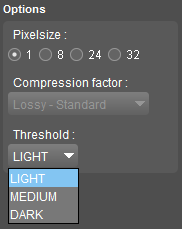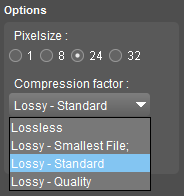Orbit Multiresolution Image
An Orbit Multiresolution Image (*.omi) is Orbit's native multiresolution image and raster file storage format.
The OMI has been developed for encoding and fast viewing of raster and image resource any size on any platform.
Structure
An OMI stores any image in an intelligent pyramid structure, see Multiresolution Image data.
Reasons to use
- fast viewing of large datasets (+100 Gb)
- support for black/white, grey-scale and color images
- platform independent and can be shared among Windows, Linux and Mac platforms.
Unlike other image compression formats : e.g. Mr SID (Wikipedia Mister Sid) can only be used on Windows
Create and Update
An OMI can be created via the Map 2D Additional tools :
- Convert Imagery : Convert one on one, one Image to one OMI (or other image storage file format)
- Optimize Imagery : Convert multiple Images to one OMI
Also , an OMI can be created via the Process MM Imagery procedure, for creating OMIs from the original imagery in a run.
Options and Compression
When creating an OMI, flowing options are available to define storage and compression.

Pixelsize
Define the number of bits (1, 8, 24 or 32) to be used to store one pixel of (raster or image) resource 1)
| Bits/Sample | Samples/Pixel | Bits/Pixel | Image type |
| 1 | 1 | 1 | Monochrome black-white |
| 8 | 1 | 8 | Grayscale |
| 8 | 3 | 24 | RGB (red green blue) |
| 8 | 4 | 32 | ARGB (alpha/transparency RGB) |
Pixelsize 1
A pixel can hold one sample with 2 possible values 0 (black) or 1 (white).
When using pixelsize 1, it will be possible to set a threshold : Light, Medium or Dark.
Applying a threshold is a method to simplify an image to sets of pixels with corresponding values. The result is an image containing contiguous regions of the same value. This technique makes it easier to apply analysis.
- Light will favor light color values.
- Dark will aggregate dark color values.
Pixelsize 24

A pixel can hold 3 samples with a value between 0 .. 255.
Using pixelsize 24 enables extra quality parameters. :
- Lossless “fully recoverable”, no compression
- Lossy “with losses to quality”
- Smallest file
- Standard
- Quality
Lossy meaning “with losses to quality”. Approximate sample values will be stored with sample value compression rate 5:1 up to 20:1
Examples .jpg, .ecw, .sid
Lossless always returns the original data. Lossless meaning “fully recoverable”. The exact sample values will be stored.
Examples : .gif, .png, .bmp
It is advised to save images with a wide variety of colors (photos) with lossy compression (jpg).
Images with a limited variety (computer graphics, icons) should be saved lossless (png).
Pixelsize 8 and 32 have no extra format options.
When creating an OMI one need to choose the type of compression Lossless or Lossy (Smallest File, Standard or Quality).
A Lossy compression will use JPG compression techniques to store the multi-resolution images.
Legend and Georeference
Optionally an OMI can be accompanied by an Image World File, Orbit Legend and Orbit Resource Descriptor in Orbit.